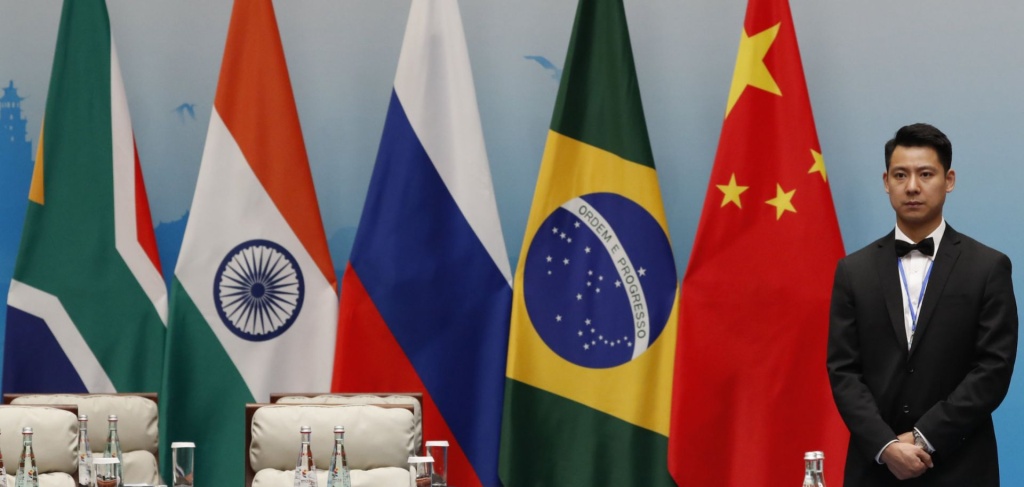BRICS is an acronym that stands for Brazil, Russia, India, China, and South Africa, five major emerging economies that have formed a political and economic alliance since 2009. The group represents about 43.2% of the world population, 26.9% of the world land area, and 29.3% of the world GDP (PPP) as of 2023. The BRICS countries have a common vision of enhancing their cooperation, promoting multilateralism, and reforming the global governance system to reflect the changing realities of the 21st century.
The BRICS group was originally conceived as a concept by Jim O’Neill, a former Goldman Sachs economist, who predicted in 2001 that the four BRIC countries (excluding South Africa) would collectively dominate the global economy by 2050. The first formal summit of the BRIC leaders took place in Yekaterinburg, Russia, in 2009, where they discussed issues such as the global financial crisis, climate change, energy security, and food security. In 2010, South Africa was invited to join the group, making it BRICS. Since then, the BRICS countries have held annual summits to deepen their strategic partnership and coordinate their positions on various regional and international matters.
What are the main achievements and challenges of BRICS?
The BRICS countries have achieved significant progress in various fields of cooperation, such as trade, finance, infrastructure, health, education, science and technology, culture, and people-to-people exchanges. Some of the notable achievements include:
- The establishment of the New Development Bank (NDB) in 2014, which aims to provide financing for infrastructure and sustainable development projects in BRICS and other developing countries. The NDB has approved over $20 billion worth of loans for 62 projects in 28 countries as of July 2020.
- The creation of the BRICS Contingent Reserve Arrangement (CRA) in 2015, which is a $100 billion fund that provides mutual support to BRICS members in case of balance of payments difficulties or currency crises.
- The launch of the BRICS payment system in 2020, which is a cross-border payment network that enables transactions in local currencies among BRICS members and reduces their dependence on the US dollar and SWIFT.
- The publication of the BRICS Joint Statistical Publication in 2020, which is a comprehensive report that provides comparable data and indicators on various aspects of BRICS economies and societies.
- The announcement of the BRICS basket reserve currency in 2020, which is a virtual currency that consists of a weighted average of the five national currencies of BRICS members and serves as a reference for trade and investment among them.
However, the BRICS group also faces some challenges and limitations that hinder its full potential and effectiveness. Some of these include:
- The lack of a formal institutional structure and a permanent secretariat that could facilitate coordination and decision-making among BRICS members.
- The divergence of interests and priorities among BRICS members on some key issues, such as human rights, democracy, security, and regional conflicts.
- The competition and rivalry among BRICS members, especially between China and India, which have border disputes, trade imbalances, and strategic differences.
- The impact of external factors, such as the COVID-19 pandemic, the US-China trade war, the sanctions imposed by the US and its allies on some BRICS members (such as Russia and Iran), and the rise of populism and protectionism in some parts of the world.

What is the future outlook of BRICS?
The BRICS group has shown its resilience and adaptability in facing the challenges posed by the changing global environment. The group has also demonstrated its ambition and aspiration to expand its membership and influence in the world. In August 2020, at the 15th BRICS Summit held online due to the COVID-19 pandemic, South African President Cyril Ramaphosa announced that six new countries had been invited to join the bloc: Argentina, Egypt, Ethiopia, Iran, Saudi Arabia, and the United Arab Emirates. The full membership of these countries will take effect on January 1, 2024.
The expansion of BRICS will add more economic heft, geographic diversity, and political clout to the group, as well as more opportunities and challenges. The new members will bring their own perspectives and interests to the table, which may enrich or complicate the BRICS agenda and dynamics. The enlarged BRICS will also have more potential to play a bigger role in shaping the global order and addressing the common challenges faced by humanity, such as poverty, inequality, climate change, terrorism, and cybercrime.
Is BRICS a threat to the USA?
The relationship between BRICS and the USA is complex and multifaceted. On one hand, the BRICS countries have expressed their willingness to cooperate with the USA on issues of mutual interest and benefit, such as counter-terrorism, non-proliferation, health, and energy. On the other hand, the BRICS countries have also challenged some of the key tenets of US global leadership, such as its unilateralism, interventionism, and hegemony. The BRICS countries have advocated for a more democratic, multipolar, and inclusive world order that respects the sovereignty, diversity, and development of all nations.
The BRICS countries have also taken concrete steps to reduce their dependence on the US dollar and the US-dominated financial system. They have launched their own development bank, reserve fund, payment system, and basket currency to diversify their sources of funding, trade, and investment. They have also increased their use of local currencies in bilateral and multilateral transactions among themselves and with other developing countries. These initiatives aim to enhance their financial autonomy and resilience in the face of external shocks and pressures.
Therefore, it can be argued that BRICS is not a direct threat to the USA, but rather a competitor and a challenger. The BRICS countries do not seek to overthrow or replace the USA as the dominant power in the world, but rather to balance and reform its role and influence. The BRICS countries also do not form a cohesive or coherent bloc that acts in unison against the USA, but rather a diverse and dynamic group that has its own internal differences and external relations. The BRICS countries are not anti-US per se, but rather pro-BRICS.

What is BRICS’ approach to cryptocurrencies and digital currencies?
Cryptocurrencies are digital assets that use cryptography to secure transactions and control the creation of new units. They operate on decentralized networks that are independent of central authorities and intermediaries. Cryptocurrencies offer some advantages over traditional currencies, such as lower transaction costs, faster settlement times, greater transparency, and increased financial inclusion.
Digital currencies are electronic versions of fiat currencies that are issued and regulated by central banks or other authorized entities. They can be either centralized or decentralized, depending on the degree of control and oversight exercised by the issuer. Digital currencies can offer some benefits over physical cash, such as convenience, security, traceability, and programmability.
The BRICS countries have shown different levels of interest and involvement in cryptocurrencies and digital currencies. Some of them have developed or are developing their own digital currencies (such as China’s digital yuan and Russia’s digital ruble), while others have adopted or are adopting existing cryptocurrencies (such as Brazil’s acceptance of Bitcoin as a legal payment method and South Africa’s launch of a crypto exchange platform). However, there are also some challenges and risks associated with cryptocurrencies and digital currencies, such as volatility, security breaches, regulatory uncertainty, and illicit activities. Therefore, the BRICS countries need to adopt a balanced and coordinated approach to regulate and leverage cryptocurrencies and digital currencies for their mutual benefit and development.
Conclusion
BRICS is a unique and influential group of emerging economies that have formed a strategic partnership based on shared interests and values. The group has achieved remarkable progress in various fields of cooperation, such as trade, finance, infrastructure, health, education, science and technology, culture, and people-to-people exchanges. The group has also faced some challenges and limitations that stem from its diversity, complexity, and external environment. The group has shown its willingness and ability to overcome these difficulties and adapt to the changing global situation. The group has also expressed its intention and aspiration to expand its membership and influence in the world. The group may explore further the potential role of cryptocurrencies and digital currencies in enhancing their financial cooperation and innovation. BRICS is a rising force in the global economy and beyond that deserves attention and respect from the international community.






Gracias
Anything that’s not the dollar is a threat to the United States.